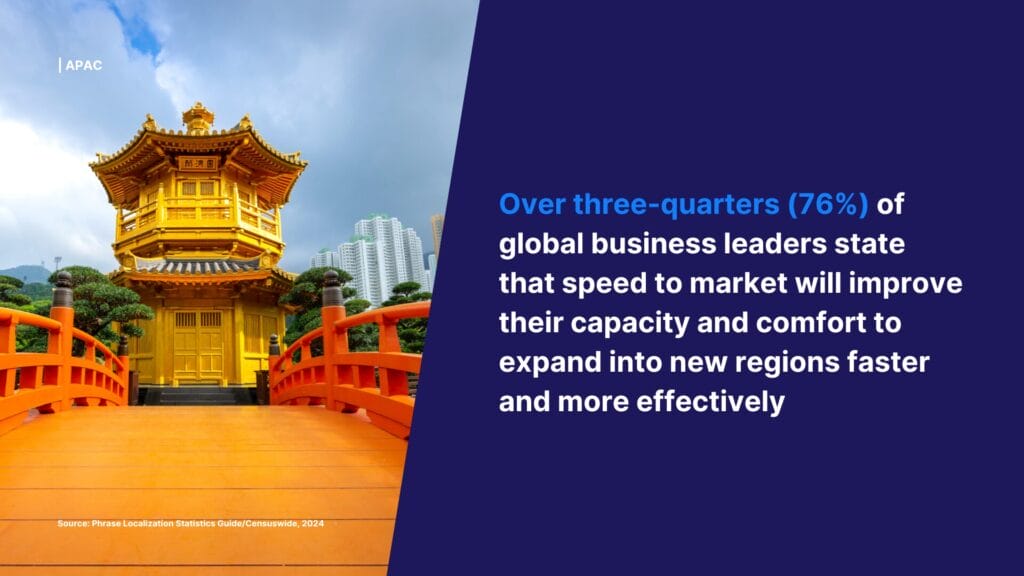Expansion is key to future growth and success for many businesses, but this global growth requires a local approach.
This article draws on exclusive research conducted by Censuswide for Phrase, surveying 2,000 business leaders globally, to explore how businesses are approaching international expansion and the common hurdles they face.
The findings reveal that while 75% of business leaders see a direct link between their global footprint and their ability to win new business and strengthen existing relationships, 54% admit their organizations struggle to communicate effectively with international audiences.
Adapting value propositions, marketing content, and products to suit local audiences is essential. While language plays a central role, cultural nuances, preferences, and habits are equally important.
Done right, this approach fosters deeper connections with customers, enhances brand reputation, and drives loyalty. With 90% of businesses planning international expansion in the next five years, those that invest in a well-executed market entry strategy will be best positioned for sustainable growth.
Throughout this article, we’ll highlight key findings from the research, showcasing the strategies businesses are using to drive revenue growth, enhance marketing effectiveness, and strengthen their competitive position in international markets.
Driving revenue and market growth
Effective content is vital for connecting with customers, but language and cultural barriers can slow market entry and weaken engagement. In fact, over half (57%) of business leaders cite language barriers as a challenge to expansion.
A well-executed localization strategy helps overcome these obstacles, enabling businesses to engage global audiences more effectively and unlock new revenue opportunities.
Tailoring content to new markets
92% of businesses globally are translating and localizing their website content, or plan to do so. This enables brands to reach consumers who would otherwise be alienated by content in a language they are not familiar with.
According to The CSA, 72.4% of consumers are more likely to buy a product with information in their own language, while 82% would not buy at all if content was not in their native language.
With more than half (59%) of business leaders finding that adapting marketing content is challenging when expanding their business, a focus on localization is essential.
Increased conversion rates
Marketing messages created in the local tongue, with messages designed to appeal to local idioms and preferences, are more likely to resonate, which has a direct impact on conversion rates.
Shopify data highlights this link between localization and sales, finding that translation increases conversion rates by 13% on average.
Retention as a revenue driver
Retaining customers is often more profitable than acquiring new ones. Building trust and familiarity through tailored experiences encourages repeat business—especially when businesses adapt to local preferences and expectations.
Existing customers are likely to spend more, are more open to new products and services, and are often the cohort contributing to the majority of revenue. A focus on retention, through a more personalized approach, can pay dividends, as some stats suggest that just a 5% increase in customer retention can increase company revenue by 25-95%.

Gaining competitive advantage with a local approach
Companies that tailor their offerings are better equipped to compete. Businesses without localization strategies risk falling behind, particularly in areas such as brand credibility (48%), communications (42%) and speed to market (41%).
Competition is a major challenge for nearly two-thirds of global business leaders when expanding into new markets. Standing out requires a deep understanding of local audiences, effective communication, and strategies that resonate in each region.
Adapting to local needs strengthens customer connections, enhances brand credibility, and ensures a more relevant market approach.
Maximizing ROI from marketing
Marketing and advertising which has been adapted to audience preferences consistently deliver higher ROI.
In one study, Facebook ads with localized copy outperformed standard ads by 22% for women and 87% for men, demonstrating the impact of localization on audience engagement and acquisition costs.
By adapting products, messaging, and customer experiences to local markets and audiences, businesses can achieve improvements in customer acquisition, engagement, and retention, all of which directly impact revenue growth.
Accelerating speed-to-market with technology
Localization and translation have often been seen as a relatively slow and costly process. With sophisticated AI-powered Translation Management Systems, localization becomes a growth lever – one which can speed up time to market and enable faster global expansion.
73% of business leaders globally believe in the potential of AI and LLMs, and are excited by the prospect of AI to drive business expansion.
However, 57% of businesses globally are not currently harnessing the power of AI and large language models to unlock new opportunities, improve operational efficiencies and enhance customer experiences.
More than three-quarters (76%) of global business leaders believe that speed to market will improve their capacity and comfort to expand into new regions faster and more effectively.

Modern AI-powered localization technology transform localization into a growth driver by increasing efficiency and reducing time-to-market. Businesses can scale translation efforts without proportional cost increases, enabling faster, broader market entry.
For example, Deliveroo currently operates in more than ten markets, with over 170,000 delivery partners. During its international expansion, it needed the processes and technology which could handle an increasing volume of translated content
Using the Phrase Localization Platform, Deliveroo was able to centralize localization and offer a consistent customer experience across every market.
Using Phrase, Deliveroo achieved:
- Three to four day reduction in project timelines.
- 40% time savings for localization managers, developers, and designers.
- Market leadership ranking 1st or 2nd in most markets with improved quality and customer satisfaction
- Personalized experiences: No matter where the customer is, Deliveroo ensures a local feel in their services.
“Deliveroo wouldn’t have a localization process without Phrase. Investing in the Phrase Localization Platform, we have managed to centralize the process and ensure consistency with all types of content. Most importantly, thanks to Phrase, we’ve helped improve time to market and customer satisfaction in new regions.” – Cristina Marín, Senior Localization Manager, Deliveroo.
Scaling with ease with AI-powered automation
Key to efficient global expansion is a centralized Translation Management System (TMS) and sustainable workflows that enable scalability across international markets. A TMS streamlines operations by managing teams, vendors, and projects in one place, offering features like user management, reporting, and invoicing.
Automation powered by AI enhances speed-to-market by reducing manual tasks while ensuring consistent, high-quality output. Businesses can release products faster, lower operational costs, and stay competitive by adapting at scale.
Customer engagement platform Braze, scaled for global growth by aligning localization efforts with business priorities, accelerating the company’s go-to-market strategy without compromising on customer experience
“Phrase didn’t just help us localize content, it transformed how we approach global growth, enabling us to enter new markets faster and with greater impact. The ability to quickly adapt to new markets and deliver a consistent customer experience with high quality localized content, has become a differentiator for Braze.”
IARA ALTKORN
LOCALIZATION OPERATIONS LEAD
BRAZE

Powering customer engagement worldwide: How Braze scaled for global growth
Ensuring consistency of brand messaging
Brand consistency is a challenge for brands operating across multiple languages and markets. It’s about achieving the right balance between adapting content to deliver relevant messaging, while still being true to the brand.
Brand consistency helps to establish credibility and trust among potential consumers. When a brand appears the same way across different languages and markets, it fosters a sense of reliability and familiarity. This can also reinforce brand values and key messaging, so customers understand what a brand stands for, wherever they are.
However, more than half (57%) of global,and 75% of US business leaders find maintaining brand consistency a challenge when expanding their business globally.
A Facebook study found that consistency was one of the four main drivers of brand loyalty, so it’s important to make this a key focus.
Brand consistency across different languages and markets requires the right strategy and tools. You need to ensure that you are able to communicate and sell effectively without compromising on who you are or what your product is about.
50% od business leaders confirmed their businesses are not currently communicating and building trust and brand recognition through a consistent global brand image, so there is plenty of room for improvement.
To do this successfully, you should tailor your content for each region specifically while staying true to your brand.
Translation Management Systems can help to ensure consistency in a number of ways:
- Real-time project oversight and language management – Track progress, identify issues as they arise, and maintain control over deadlines, quality, and resource allocation across multiple markets.
- Integrated glossaries, brand guidelines, and style guides – Ensure consistency across all localized content by automatically applying predefined brand terminology, reducing inconsistencies and manual corrections.
- Translation memories – Store and reuse previously approved translations to speed up the process, enhance consistency, and lower costs by eliminating redundant work.
- Real-time collaboration on a single platform – Keep all stakeholders—project managers, linguists, marketing teams, and developers—aligned with seamless communication, automated workflows, and transparent tracking.
The strategic value of localization
The lack of a robust localization strategy can negatively impact sales, brand reputation, and market penetration. Over half (55%) of business leaders globally admit their companies have lost business due to the lack of a proper localization strategy and nearly two-thirds (65%) have faced instances where the lack of localization has negatively impacted their business.
By embedding localization into growth strategies, businesses can deliver relevant content, improve customer experiences, and measure ROI through metrics such as revenue growth, market share, and customer satisfaction.
Furthermore, advanced analytics capabilities offered by modern localization technology, allows businesses to measure the financial impact of localization efforts by linking them to outcomes such as revenue growth, market penetration, and customer satisfaction.
It enables informed decisions on translation management budget and global expansion, with evidence of ROI backing up arguments for greater investment.
Localization plays a key role in strategic business growth, while enabling businesses to move into new markets efficiently, through cost-efficient processes.
98% of US and 87% of global business leaders have confirmed that investing in translation/localization has contributed to the successful expansion of their business in new markets.
For example, by investing in localization technology, Zendesk was able to cut localization project analysis time from hours to minutes, achieving a 96% time saving. Additionally, shifting from human to machine translation with Phrase has reduced translation costs by over 25%, further boosting efficiency.
“Phrase gives Zendesk the ability to automate many processes, allowing us to use AI solutions effectively. With the right automation in place, we can scale our operations further and continue to improve quality.”
Yoko Drain, Sr. Director of Product Globalization at Zendesk

Discover how Zendesk empowers new connections through global scalability and superior localization
Conclusion: Localization as a business growth Imperative
Global expansion offers businesses huge potential, but success hinges on the ability to adapt products, marketing, and customer experiences to meet the unique preferences of local audiences.
The research results highlighted in this post reveal a critical insight: companies that prioritize adapting market-specific strategies are better equipped to scale, drive revenue, and foster long-term customer loyalty.
Localization plays a crucial role in enabling this success. It ensures that businesses can effectively communicate, engage, and build trust with international audiences, turning expansion efforts into sustainable growth. By integrating localization into their operational frameworks, companies can achieve:
- Enhanced speed-to-market: Automated Translation Management Systems (TMS) powered by AI accelerate localization processes, reducing project timelines and enabling faster international launches.
- Scalable operations: AI-driven localization technology allows businesses to expand into new markets efficiently without adding proportional costs or complexity.
- Brand consistency and trust: Maintaining a unified global brand while delivering culturally relevant content fosters trust and strengthens brand equity.
- Higher customer engagement and retention: Tailored customer experiences drive deeper emotional connections, higher conversion rates, and increased lifetime value.
- Competitive market positioning: Businesses that localize effectively gain a competitive edge by entering new markets before competitors and responding swiftly to market changes.
As this article highlights, the risks of ignoring localization are substantial. Over half of global business leaders admit to losing business due to insufficient localization, while two-thirds report direct negative impacts from failing to adapt content for international markets.
The path to international success is clear. Businesses must embrace localization as a strategic lever for growth—not simply as a cost, but as a revenue-driving, brand-building, and customer-retention enabler.
With 79% of business leaders globally expecting the role of localization to evolve further in the next three years, companies that prioritize localization today will be better equipped to lead in the competitive, interconnected markets of tomorrow.
Want to find out more?
The phrase business case for global expansion lays out the most important metrics and measures that organizations face as they strive for scale on the international stage.






